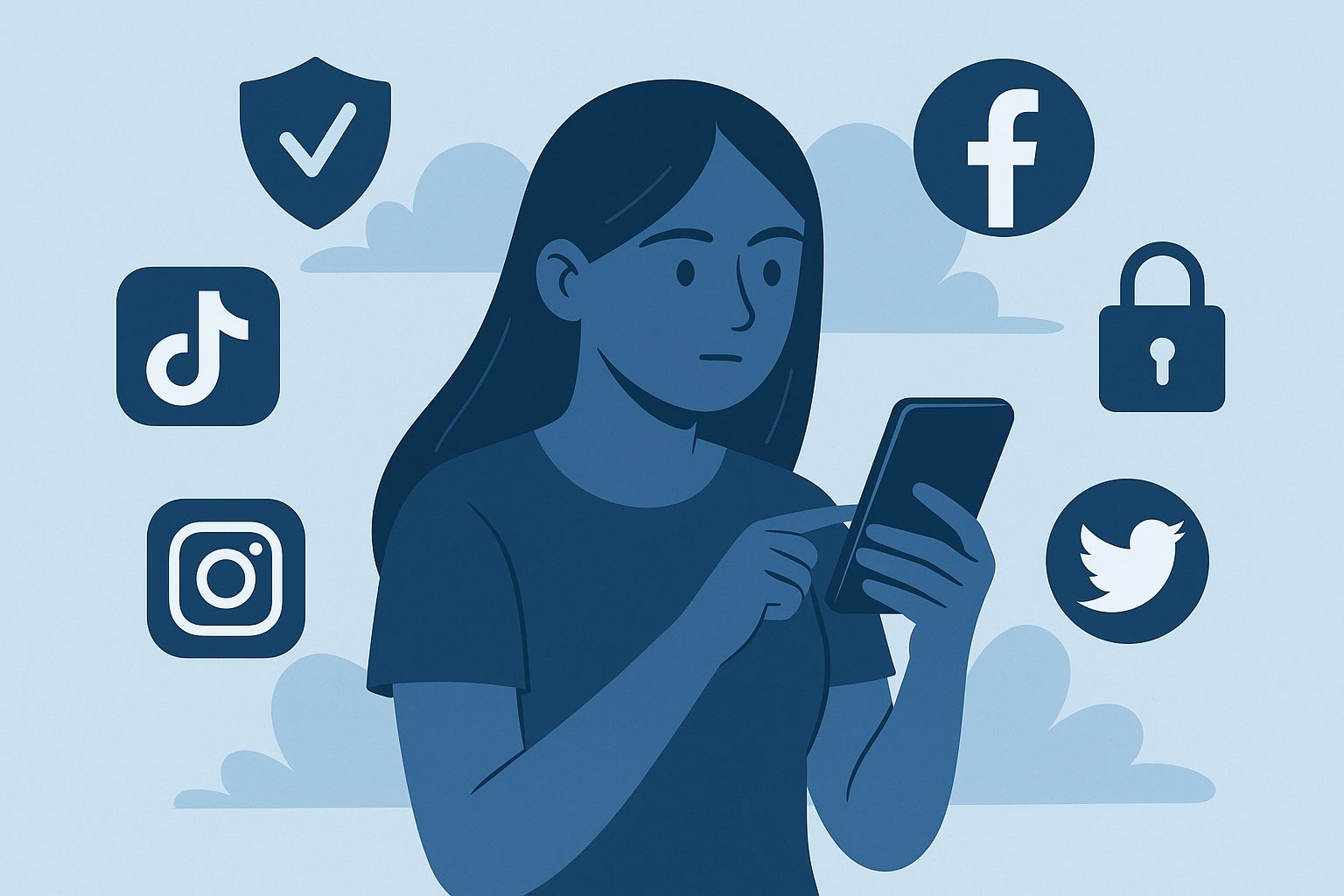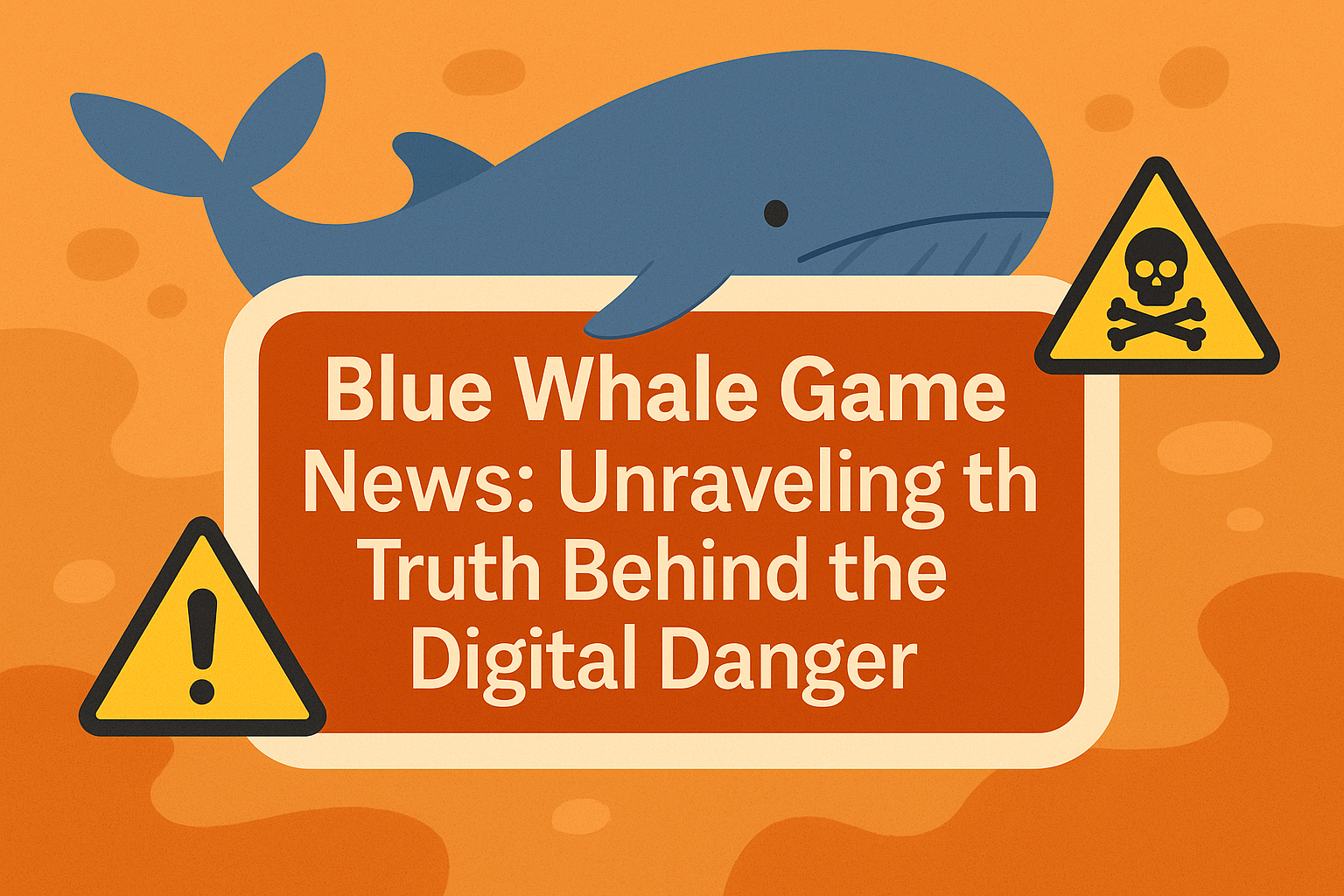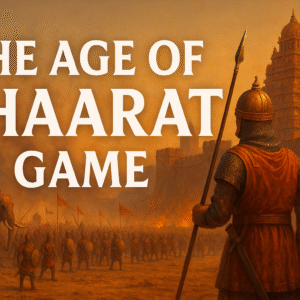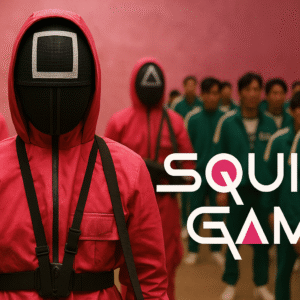Table of Contents
A Dangerous Challenge Hidden in the Shadows
In recent years, the internet has become a space where creativity, community, and chaos coexist. One of the most disturbing stories to emerge from the darker side of digital culture is the Blue Whale Game, a so-called “suicide challenge” that reportedly led to the deaths of multiple teenagers across the globe. Although often surrounded by media hysteria and misinformation, blue whale game news continues to surface online, triggering concern among parents, educators, and law enforcement agencies.
My first encounter with the blue whale game news was through a forwarded message on WhatsApp, warning parents to watch their kids’ phone usage. It seemed like just another viral hoax—until I dug deeper. The reality was far more complex, chilling, and important to understand. This blog explores the truth behind the headlines, the psychological impact on teens, and what we can learn from this tragic online phenomenon.
Origins of the Blue Whale Game: What Is It Really?
The blue whale game allegedly started in Russia around 2016, reportedly created by Philipp Budeikin, a psychology student who was later arrested. According to Russian authorities and media outlets like BBC, Budeikin claimed that he wanted to “clean society” by targeting teenagers he considered “biological waste.” This deeply disturbing justification has been the core of most blue whale game news updates.
The game allegedly involved a series of 50 tasks given to participants, which included watching horror movies alone, inflicting self-harm, and ultimately committing suicide. The tasks were said to be handed out by anonymous “curators” through social media or messaging apps like VK (a Russian platform similar to Facebook).
What made the blue whale game news alarming was the slow, psychological manipulation it entailed. Teenagers, often already struggling with anxiety, depression, or loneliness, became easy targets. While many of the stories surrounding the game are hard to verify, there were enough confirmed cases that prompted governments and child safety groups to take notice.
Blue Whale Game News Around the World: Real Incidents or Hype?
The first wave of panic hit Russia and nearby countries. Soon, blue whale game news began appearing in India, Brazil, the UK, and even the United States. In India, particularly, the game became a hot topic following the reported suicide of a Mumbai teenager in 2017. The Indian Express reported that the boy had taken a selfie moments before jumping from a high-rise, allegedly completing the final task.
Authorities in India responded swiftly. The Ministry of Electronics and IT issued warnings to internet companies like Google, Facebook, and WhatsApp, asking them to take down all links related to the challenge. Schools across the country issued advisories to parents. Despite these efforts, blue whale game news kept emerging—mostly triggered by concerned communities or viral social media posts.
In Brazil, a similar pattern emerged. According to a report by The Guardian, dozens of teens were suspected of being influenced by the game. Investigations were launched, but law enforcement often struggled to confirm direct links between the suicides and the challenge.
That’s what makes blue whale game news so elusive. It’s part reality, part myth. And in the age of viral misinformation, separating facts from fiction becomes increasingly difficult.
Digital Manipulation and Psychological Traps
Let’s talk about the psychology. As someone who has worked with teenage focus groups during digital literacy workshops, I’ve seen firsthand how easily teens can be influenced online. The blue whale game took advantage of this vulnerability. The curators (if real) allegedly used fear, coercion, and emotional blackmail to trap users.
What’s worse, many teenagers didn’t share their involvement with family or friends. The challenges promoted secrecy and loyalty to the “game.” Once emotionally entangled, participants feared consequences if they tried to quit. Some were reportedly told their families would be harmed if they didn’t obey orders.
One 15-year-old girl from the UK, as reported in The Sun, was found with self-harm injuries and had searched for blue whale game content online. Thankfully, her parents intervened in time.
The biggest takeaway from all the blue whale game news reports is that this wasn’t just a “game.” It was psychological warfare disguised as a challenge. And for vulnerable teens, that distinction becomes dangerously blurred.
The Role of Social Media Platforms

Social media companies were slow to respond in the early days. Platforms like TikTok, Instagram, and Facebook initially dismissed the challenge as an internet hoax. But as blue whale game news began trending and real-life consequences became apparent, the tone shifted.
Meta (formerly Facebook) began automatically blocking posts and groups using certain keywords. YouTube updated its policy to demonetize or remove content that promoted self-harm or dangerous challenges. Even TikTok introduced safety alerts that redirected users searching for harmful trends to mental health resources.
However, the decentralized nature of the internet makes it hard to erase every trace of the challenge. Curators (if they exist) often use code words, emojis, or fake profiles to avoid detection. The blue whale game news cycle is, therefore, not just about one viral story—it’s about an ongoing failure in digital content moderation.
Case Study: India’s Response to the Challenge
India’s reaction to the blue whale game news was among the most aggressive globally. Following the suicide reports, the Supreme Court of India issued notices to the Central Government, demanding action. Schools across Delhi, Mumbai, and Bangalore conducted awareness campaigns. Some NGOs even launched helplines for teenagers feeling trapped or suicidal.
One of the NGOs I personally collaborated with, based in Pune, conducted over 40 school seminars within three months. During our sessions, we realized most kids had heard of the blue whale game but didn’t understand the seriousness. Many believed it was “just a scary game like Slenderman.”
The real challenge, we found, wasn’t just the game—it was the digital illiteracy. Parents didn’t know what apps their kids were using. Schools lacked proper digital safety training. And teens didn’t feel safe enough to talk about mental health issues at home.
The blue whale game news shook the country awake, but the real solution lay in education, not censorship alone.
Media Sensationalism vs. Reality: The Fine Line
When it comes to blue whale game news, one challenge has been distinguishing between confirmed incidents and overblown panic. Traditional media outlets often published sensational headlines without complete verification. Phrases like “deadly game spreading like wildfire” became common across newspapers and television news.
A critical report by Snopes examined several viral claims and found many of them were either exaggerated or lacked sufficient evidence. For example, some suicides initially attributed to the game were later found to have no connection upon investigation. This led to criticism of the media for fueling unnecessary hysteria.
As someone who works in content strategy, I can confirm that headlines involving fear or danger perform exceptionally well. And in this case, it may have created a feedback loop. The more blue whale game news was shared, the more parents panicked, and the more likely teenagers became curious about the “game.”
It’s a grim reminder of the media’s role in amplifying fear. Responsible journalism should investigate and verify before publishing. Instead, many outlets jumped on the trend for traffic, causing misinformation to spiral further.
The Rise of Copycat Challenges
Another alarming trend that followed the blue whale game news was the rise of similar “challenges” online. The internet saw a surge in dangerous games like the Momo Challenge, Fire Challenge, and Choking Game, many of which were promoted in the same vein as Blue Whale.
A study by the Journal of Adolescent Health found that viral internet challenges can act as triggers for self-harming behavior, especially in vulnerable teens. The Blue Whale incident set a precedent, showing how quickly dangerous trends could travel across borders and platforms.
Some of these challenges weren’t even real—merely urban legends that gained traction due to public anxiety and media attention. But real or not, the damage lay in the perception. The psychological effect was the same: fear, panic, curiosity.
What blue whale game news revealed was that the internet has a dark side that can’t be ignored. The battle isn’t just against a single game, but a larger pattern of manipulation and misinformation.
Technology Companies’ Ongoing Battle
After global backlash, many tech companies began updating their safety measures. Google implemented stricter search filters and partnered with NGOs to show suicide prevention hotline information to users searching for keywords related to self-harm. Twitter began flagging and hiding harmful tweets. Meta and TikTok followed with content moderation policies.
Despite these steps, digital loopholes persist. The blue whale game news continues to re-emerge every few months, sometimes under new names or disguised in code words to avoid detection.
The real solution isn’t banning keywords—it’s building platforms that prioritize mental wellness. Tools like Instagram’s “sensitive content” warning, or YouTube’s mental health resource banners are good starts. But enforcement is inconsistent. A few clicks on lesser-known forums or Telegram groups can still expose users to disturbing content.
This brings us to a personal reflection. A friend of mine who works in a cybersecurity firm showed me a case where someone hosted Blue Whale-like instructions on an obscure blog, evading AI moderation tools entirely. It showed how adaptable these malicious actors are—and why our defenses need to evolve faster.
What Parents and Schools Can Actually Do
If there’s one thing I learned from tracking blue whale game news, it’s that banning internet access doesn’t work. Instead, we need smarter parenting and better digital education in schools.
Here are a few effective practices we implemented in our seminars:
- Open communication: Teens need safe spaces to talk without judgment. When you show trust, they’re more likely to share uncomfortable truths.
- Device literacy: Parents should understand the apps their kids use. Setting up parental controls without understanding the context is counterproductive.
- Collaborative browsing: Families can set certain times to explore online content together. It builds transparency without being invasive.
- School involvement: Teachers should be trained in identifying behavioral changes linked to digital issues. Awareness sessions should go beyond “don’t do drugs” talks.
One Indian school even developed a program where students learned to debunk online hoaxes—turning digital threats into learning opportunities. That’s the kind of smart response we need more of.
Mental Health Must Be the Focus
While blue whale game news became a digital safety issue, its root was always about mental health. Teen depression, anxiety, peer pressure, and the lack of emotional outlets are what make kids vulnerable in the first place.
Organizations like AASRA, iCall, and Samaritans offer 24/7 mental health support in multiple languages. More awareness about these services is crucial.
In one of our follow-ups, a 17-year-old participant told us, “I didn’t play the game, but I was curious because I felt alone. The media made it sound like a place to connect—twisted, but that’s how it felt.”
That shook me. The blue whale game news had made its way to someone not out of thrill, but out of emotional need. We must remember this isn’t about tech alone—it’s about human connections.
Expert Opinions on the Blue Whale Game News
To further understand the psychological depth of the issue, I spoke with a clinical psychologist, Dr. Niharika Malhotra, who specializes in adolescent behavior and digital addiction. Her insights were blunt but eye-opening:
“What the blue whale game news exposed was a failure of support systems—at home, at school, and on the internet. We saw teenagers crying for help, but they were doing it silently through coded participation in a viral trend. It’s not the challenge that kills them—it’s the loneliness.”
She further explained how dopamine loops play a role in why these “challenges” are addictive. Teens experience small hits of reward from completing each task, which escalates into riskier behavior. This isn’t new—gaming addiction, social media scrolling, even gambling rely on the same mechanisms.
In her opinion, the Blue Whale Game wasn’t just a viral dare—it was a reflection of unresolved trauma, unmet needs, and ignored voices. That’s a message every stakeholder, from parents to policymakers, must understand deeply.
Law Enforcement and Policy Shifts
Following the early blue whale game news, various countries began enforcing new digital safety laws. In India, the IT Ministry requested immediate removal of any links or references to the game. Brazil’s police departments set up cybercrime units specifically trained to deal with similar threats. The UK’s Child Exploitation and Online Protection Centre (CEOP) also began community outreach programs.
One key takeaway was the legal grey area surrounding online games. Since most platforms did not host the game directly, prosecuting individuals became difficult unless clear evidence of coercion was found.
However, countries like Russia and Kazakhstan pushed for criminalizing the spread of such digital games, especially if they led to harm. In some cases, curators were arrested, though proving their direct link to specific suicides remained difficult.
The shift in policy was reactive—but necessary. Blue whale game news forced lawmakers to rethink how they regulate digital spaces, especially those impacting minors. Unfortunately, it often takes tragedy to provoke change.
Blue Whale Game Hoaxes and False Reports
With the rise of real cases also came a wave of hoaxes and false claims, which clouded the real issues. News outlets and social media pages began circulating fake images, edited screenshots, and even completely fabricated “task lists.”
In one incident in the Philippines, a popular Facebook post claimed the game had reached 200+ schools—only to be later debunked. A similar scare in Pakistan turned out to be linked to a fake YouTube video that had gone viral, triggering local protests.
I recall receiving a forwarded message with dramatic emojis and phrases like “URGENT—PROTECT YOUR CHILDREN FROM DEATH GAME!” That’s when I realized misinformation was just as dangerous as the challenge itself.
Websites like FactCheck.org and AltNews later stepped in to clarify many such claims, proving how essential digital literacy has become.
Blue whale game news, in many ways, became a case study in how fear spreads faster than facts.
Author’s Personal Reflection
I won’t lie—researching this article was emotionally exhausting. Speaking to students, reading case files, and watching parents cry over something that started from a smartphone screen—it made me rethink the balance between freedom and safety online.
What hit me hardest was a moment during a school seminar, when a 13-year-old girl asked, “If a game can tell someone to die, why doesn’t any game tell us how to live?” Her question was more profound than anything an adult could have asked.
That one sentence became the soul of this entire article.
Blue whale game news is not just a digital story—it’s a human tragedy shaped by broken systems. And we owe it to the next generation to learn from it, not just fear it.
What Can We Learn Going Forward?
Let’s simplify this into actionable lessons:
- Awareness over panic: Parents and schools should stay updated, but avoid hysteria. Calm, informed discussions are far more effective than bans.
- Digital education: Introduce online safety, critical thinking, and emotional intelligence in school curriculums.
- Mental health support: Increase funding and awareness for adolescent counseling—online and offline.
- Media responsibility: Encourage ethical journalism that avoids clickbait fear tactics.
- Platform accountability: Push tech companies to build AI that detects subtle psychological trends, not just keywords.
The next viral trend could be worse—or more invisible. But if we build empathy, awareness, and trust today, we might just prevent the next disaster.
Frequently Asked Questions (FAQs)
Q1: Is the Blue Whale Game still active in 2025?
As of now, there are no confirmed active versions of the game on major platforms. However, variations can appear in private messaging apps or forums. Always stay alert.
Q2: How can parents protect their children?
Maintain open communication, monitor app usage gently, and educate teens about online risks. Encourage emotional openness and offer mental health resources if needed.
Q3: Is there any official list of the 50 Blue Whale tasks?
Many online lists exist, but most are unverified or fabricated. Sharing them is discouraged as it can lead to triggering behavior.
Q4: Was anyone ever arrested for creating the Blue Whale Game?
Yes, Philipp Budeikin in Russia was arrested and convicted. However, many “curators” remain unidentified or never confirmed.
Q5: What should I do if I suspect someone is involved?
Talk to them calmly. Avoid judgment. Contact a mental health helpline or local authorities if you see signs of self-harm or suicidal ideation.




Leave a Reply